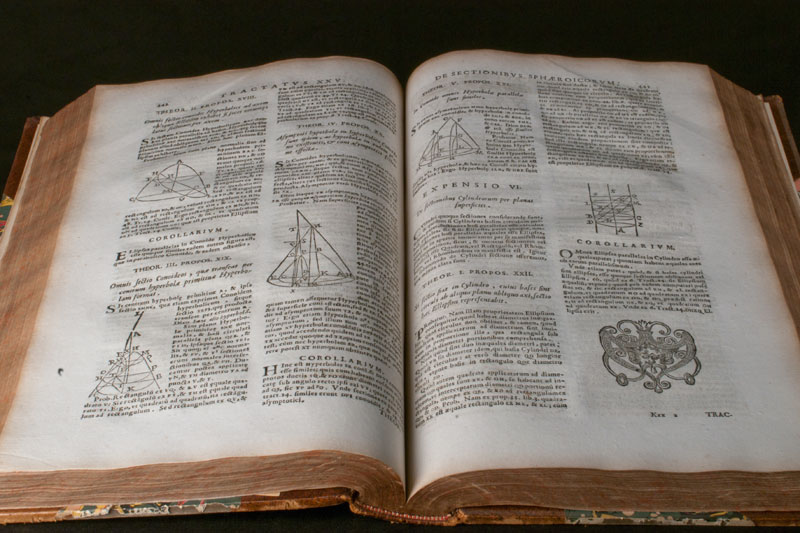The old collection from the university library
The old collection of the university library brings together a large number of rare works, books and illustrated plates. The remarkable works include: the surgery of Guy de Chauliac published in 1538; the dissection of parts of the body by Charles Estienne (1546) and de humani corporis fabrica by Vesale (1555).
Around 13,500 volumes 2,200 works before 1800
The collection that pre-dates 1700 also contains the edition by Georges Fournier on art of navigation and the Herbier by Jacobus Theodorus and Institutiones physicae by Albert Kyper.
The shared documentation service endeavours to make good use of these items and to share these riches of previous centuries by digitizing them. The digitized works can be consulted in the catalogue of the university library.
The Interfaces / Old books blog of the University of Lyon (initiative shared by SCD Lyon 1 and the Lyon Diderot library) regularly exhibits these remarkable works to the general public.
A little bit of history
The old collection (works prior to 1920) from the science and health university libraries stem from the creation of the University of Lyon in 1896. These collections come from acquisitions made during the 19th century, to which have been added donations by several Lyon families and doctors, in particular Chavot, de Polinière, Crozel-Donnat, Pétrequin and Lacassagne. The collection was enlarged by the transfer of other collections, notably those form the library of the Lycée impérial de Tournon (former Collège des Oratoriens), and part of the works from the Grand Seminary and the Archbishopric.
Books from the university library in Gallica
Partner of the French national library (BnF) in Paris, the university library has been working since 2004 to increase the number of French digitized work opening access in Gallica to various corpora of digitized documents of national value for their scientific interest and their complementary nature with the collections of the BnF. The works and journals selected are on the history of sciences, the history of medicine and pharmacy and remarkable collections such as the works and journals on homeopathy (Gallavardin collection), the forensic medicine theses supervised by Alexandre Lacassagne, and not long ago, works on the history of mathematics by Jean and Gilles Itard.
The Gallavardin collection and the beginnings of homeopathy in France
In 1962, Emmanuel Gallavardin donated an important collection of works and journals on homeopathy to the library of the faculty of medicine of Lyon. Some of these documents in this collection originally belong to Count Sébastien des Guidi (1769-1863), who introduced homeopathy to France. Jean-Pierre Gallavardin (1825-1898) treated by Count des Guidi, inherited these documents and passed them on along with contemporary documents to his sons, Jules Gallavardin (1872-1917) and Emmanuel Gallavardin (1877-1966). This exceptional collection records the introduction of homeopathy in France by way of documents such as the hand-written consultation registers of des Guidi, the first published works in French in this field. More recent documents that record the development of this form of medicine have since been added to these documents from the early period of homeopathy in France (1832-1860).
The theses of forensic medicine
Alexandre Lacassagne (1843-1924), professor at the faculty of medicine of Lyon and a forerunner of forensic medicine, supervised two hundred theses. The subjects are very varied; some are very technical and based on clinical observations; others deal with the medico-psychological profile of famous people, notably the thesis of Pierre-Gaston Loygue in 1904 is a Medico-psychological study of Dostoevsky. Others studied the actual crimes. Henri Fadeuilhe, in his thesis on Suffocation, submitted in 1897, looked at the affair referred to as the "de la rue Tavernier" and gave details of a large number of experiments carried out to determine the causes of death of a man discovered by his mistress in a trunk. The diversity of these subjects testify to this discipline, still in its infancy, and the take-off of forensic medicine.
The library of Jean and Gilles Itard
Jean Itard (1902-1979) was passionate about the history of mathematics and dedicated part of this time to looking for and acquiring mathematical works. These works, read and annotated by him, form a remarkable collection from the XVIth to XXth century. It was added to after his death by his son, Gilles, who was also a teacher of this subject. In 2010, the Itard family donated the entirety of the collection to the public documentation department. The collection has been deposited at the mathematics library. In 2013, these books were digitized in partnership with the Institut Camille Jordan. Some of the works included are: Euclid, Archimedes, d’Alembert, Euler and Chasles to cite but a few.
Access: Collection that can be viewed by researchers on-site during the opening times of the University science library (LyonTech-la Doua campus).
Contact: Livia Rapatel
Website: http://portaildoc.univ-lyon1.fr/vie-culturelle/patrimoine/



 en
en fr
fr
 es
es

